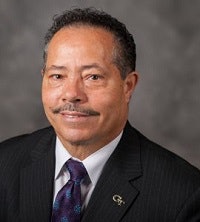ATLANTA — Those attending the National Association of Diversity Officers in Higher Education (NADOHE) 2018 Standards of Professional Practice Institute described the second annual event as affirming their experience as diversity officers.
In an effort to professionalize the ever-changing institutional role of what is broadly described as a chief diversity officer (CDO), the institute facilitated key discussions on NADOHE’s 12 standards of professional practice for diversity officers to move their institutions forward in their commitment to “inclusive excellence” for all in the campus community.
 Dr. Archie W. Ervin, NADOHE President
Dr. Archie W. Ervin, NADOHE PresidentSessions also served as safe spaces for the institutional change agents to build a community of peers to express best practices, share concerns or work through institutional challenges relative to their diversity work. Further, the institute provided professional development to participants, challenging them to leverage their capacity to accomplish their institutional goals.
Mastering the competencies of this profession is “essential to the viability” of diversity, equity and inclusion work in higher education, said Dr. Archie W. Ervin, president of NADOHE and vice president for institute diversity at Georgia Institute of Technology.
In an opening presentation Wednesday, Ervin gave an overview of the evolution of the CDO role. He said CDOs are “not a monolithic group” but are individuals with varying perspectives about how to achieve a common goal.
However, NADOHE’s “turf” is grounded in the scholarship around the legal, historical, demographic and social justice and equity components central to diversity, equity and inclusion, he said.
The institute’s faculty started by emphasizing that the work of a CDO is often erratic and unpredictable, requiring individuals to practice self-care.
“It’s not linear,” Ervin said of the work of CDOs. “It’s day-to-day.”
Thursday’s sessions — presented throughout the day by institute faculty Dr. Mitchell Chang, Dr. William B. Harvey, Dr. Benjamin Reese, Dr. Joan Holmes and Paulette G. Russell — centered on six of the 12 professional CDO standards.
Chang focused on the terms “ability” and “conceptualization” in encouraging participants to envision the diversity mission of their institution through a “broad and inclusive definition of diversity” as it relates to Standard One, “the ability to envision and conceptualize the diversity mission of an institution through a broad and inclusive definition of diversity.”
He challenged diversity practitioners at institutions to expand their “domains for diversity” and take into account that the world, higher education institutions and the definition of “diversity” itself are constantly changing.
Harvey’s session on Standard Two focused on “contextualization” so that CDOs can move the work from their office into concrete practice at their institutions. He called the academy a “change-averse” environment due to institutions’ adherence to “customs, traditions and the status quo.”
Consequently, he challenged diversity practitioners to facilitate a shift from “total responsibility” of the CDO in implementing institutional diversity efforts to a system where every member of the institution has a personal, moral and ethical responsibility to make the institution a place where a “broad array of perspectives and insights can be presented with dignity and respect.”
Beyond that, Harvey said, “Give voice to diversity in ways that continue to evolve, because the nature of institutions is evolving.”
Understanding institutional culture is essential to every diversity practitioner’s role, said Reese, NADOHE’s immediate past president, and Holmes, the recently retired Hillsborough Community College special assistant to the president for equity and special programs.
Reese, who also is vice president for institutional equity at Duke University, said CDOs should familiarize themselves with the five formal — and public — things that define an institution’s culture, as well as five informal things that are not well-known publicly.
“You can go from one institution and be a shining star, and go to another and be a failure,” Holmes said. “You have to pay attention to the culture of your institution. If you ignore the culture of your institution, [the CDO role] won’t work.”
Later sessions gave the diversity officers and practitioners a confidential space to address professional standards and challenging personal experiences in their work centered on legal issues, regulations and other policies such as those related to Title IX and Title VI, nondiscrimination, access and equity in higher education.
Harvey, founding president emeritus and a board member of NADOHE, said this year’s institute has seen several changes from the previous year. This year’s cohort of diversity officers is more engaged during the sessions, he observed.
More people are participating in the conversations, Harvey said, whereas last year, participants were more hesitant to share some of the challenges and experiences they faced in their work.
Several participants attending the institute mentioned that hearing other diversity officers’ experiences affirmed their own experience, noting that the work can be taxing.
Concerns about the CDO role being a “token position” were addressed by Dr. Nancy “Rusty” Barceló, former president of Northern New Mexico College.
“It’s only a token position if you allow it to be,” she said, garnering signs of agreement across the room. She charged diversity officers and practitioners to be “multiculturalists.”
CDOs “have to learn [the cultural history of various groups] to position ourselves in the work that we do,” said Barceló.
“Understand that you’re at the table as an equal,” Ervin added, “then exercise that assumption and be an equal.”
Tiffany Pennamon can be reached at [email protected]. You can follow her on Twitter @tiffanypennamon.





















